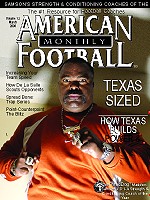AMERICAN FOOTBALL MONTHLY THE #1 RESOURCE FOR FOOTBALL COACHES
Article CategoriesAFM Magazine
|
Spreading the Boneby: H. Neal Hamrickby: Todd Allen © More from this issue We had learned the spread passing game from spending time at one of the best air-attack schools in the country, Trinity University (San Antonio), and yet we knew that something, something absolutely vital, was still missing. The question we faced was the same question college and high school coaches have faced nationwide: how do we utilize a powerful and versatile running game out of the Spread? The answer, we felt, was the offensive philosophy we dubbed the SpreadBone, which utilizes the spread passing game combined with a Wing-T inspired running attack. This offense is the subject of the forthcoming book, 'Coaching Football’s SpreadBone Offense: Spread the Field.’ The base formation of the SpreadBone (but certainly not its only formation!) is comparable to a double-slot look; unlike other teams that show a Flexbone format....The full article can only be seen by subscribers. Subscribe today!
|
|
|||||||
| HOME |
MAGAZINE |
SUBSCRIBE | ONLINE COLUMNISTS | COACHING VIDEOS |
Copyright 2025, AmericanFootballMonthly.com
All Rights Reserved





